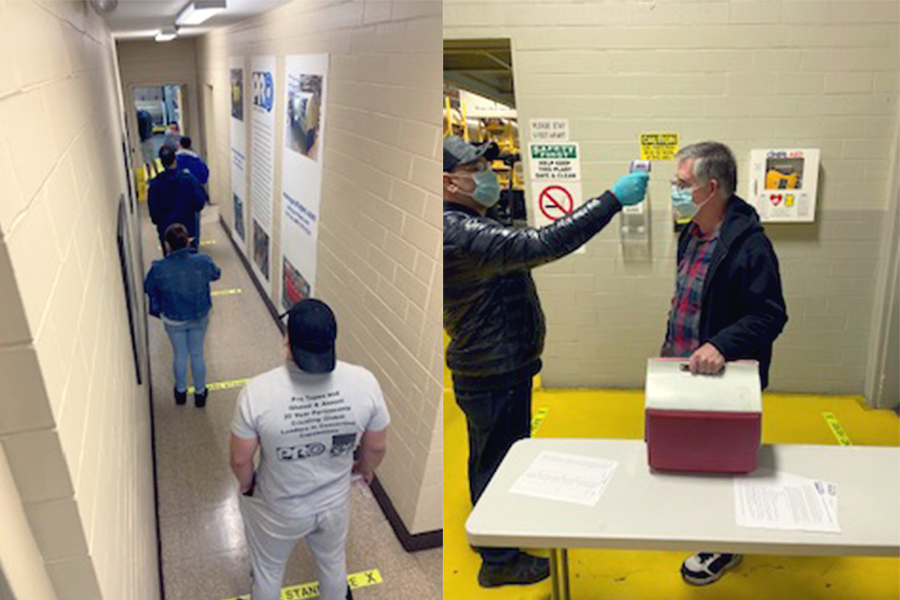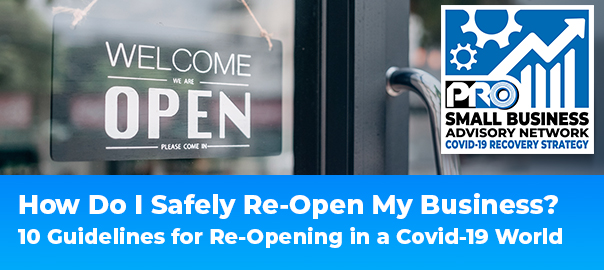As the US economy begins to slowly re-open and businesses begin to plan their reopening strategies, it’s imperative that employee safety be at the forefront of any reopening plan. In this blog, we’ll discuss ten guidelines for safely reopening your business in a covid-19 world.
Without putting the appropriate employee safety measures in place well in advance of (successfully) reopening your business, you’re destined for failure before you get started. Let’s face it, a big part of a successful reopening will be overcoming the psychological effects of this pandemic.
Many folks are scared & anxious to head back out into the world after months of being quarantined, and the last thing you need is an employee becoming ill the first week back on the job.
With that in mind, here are 10 safe-operational “Best Practices” you should consider implementing before you re-open your business:
#1: Assess your Workers’ Individual Risk Factors
Old age, presence of chronic medical conditions (including immunocompromising conditions) pregnancy; these are all factors to consider. Implement Controls necessary to address those in higher-risk categories, such as making arrangements for at-home working accommodations or physical spacing in order to isolate your high-risk employees from your lower or less at risk employees.
#2: Consider Flexible Worksites and Flexible Hours
Employers should explore whether they can establish policies and practices, such as flexible worksites (e.g., telecommuting) and flexible work hours (e.g., staggered shifts), to increase the physical distance between employees in order to avoid clusters of employees working in close physical proximity, or reducing the overall number of employees in the building at one time.
#3: Reconfigure Your Operational Layout
Consider reconfiguring your operational layout to create the appropriate physical distance between workstations, equipment & assembly lines. Where ever possible, eliminate areas that lead to employee clusters for prolonged periods of time. Eliminate the use of time-clocks that require physical touching, or excess employee congregating in one central area.

#4: Start Each Day with a Wellness Check
Establish Daily pre-work wellness checks. As each employee enters the building at the start of each business day, their temperature should be taken and recorded to insure they are not running a fever. A template form should be created to include a checkbox system indicating if your employees are experiencing any problematic symptoms (Score throat, chills, headache, stiffness or soreness, etc.)
#5: Maintain (And Improve) Good Housekeeping Practices
Maintain regular housekeeping practices, including routine cleaning and disinfecting of surfaces, equipment, and other elements of the work environment. When choosing cleaning chemicals, employers should consult information on Environmental Protection Agency (EPA)-approved disinfectant labels with claims against emerging viral pathogens.
#6: Promote Personal Hygiene (with PPE)
Create a work environment that promotes personal hygiene (and provide the resources if necessary.) For example, provide personal protective equipment such as gloves & masks, no-touch trash cans, hand soap, alcohol-based hand rubs containing at least 60 percent alcohol, disinfectants, and disposable towels for workers to clean their work surfaces. Provide the proper resources for the clean & safe disposal of all used PPE.
#7: Incorporate Health Training and Education
Incorporate health training & educational resources as part of your on-going training programs. Increasing employee awareness as to how viruses are spread and how to monitor for early warning signs of illness in themselves & fellow employees will help provide for prompt identification and early intervention of outbreaks.
#8: Encourage Sick Employees to Stay Home
Revise human resource policies to encourage sick employees to stay home when feeling ill. Provide a level of flexibility in the use of paid time off, or increase the availability of PTO in the case of illness. Provide the same level of flexibility when it comes to providing paid time off to care for sick family members or address child care concerns in the event of illness.
#9: Develop & Promote Open Lines of Communication
Develop & promote open lines of communication across your organization. Work within the privacy protections afforded your employees with HIPAA laws, but openly communicate news of any outbreaks within your organization. Develop a system that allows for speedy & accurate dissemination of information in the event that one of your employees becomes infected or has been exposed to someone who has been infected. Be able to rapidly trace all inter-employee contact within your organization, so that you can quickly notify & isolate any of your employees who may be contagious.
#10: Invest Upfront in Preventive Health Maintenance
By providing for extra paid time to allow for pre-work wellness checks, or allowing for extra paid break time to encourage proper hygiene practices like hand washing & proper disposal of used PPE, you’re actually saving money by preventing a very costly outbreak. It’s important to remember that the cost you’re investing on these up front preventive measures, will pale in comparison to the cost you’ll incur if you experience a wide spread breakout. Remember, without our heath we have nothing.



















